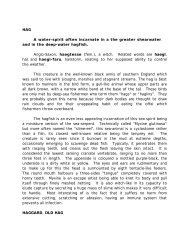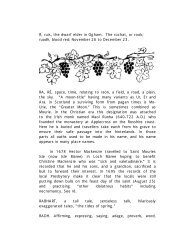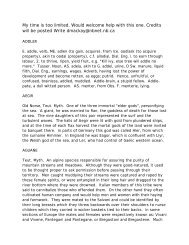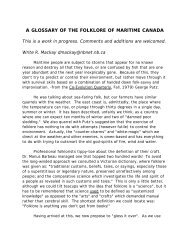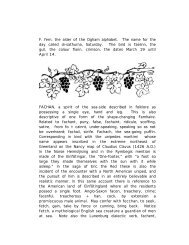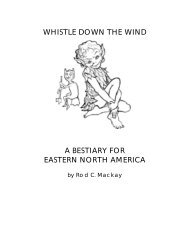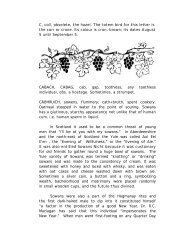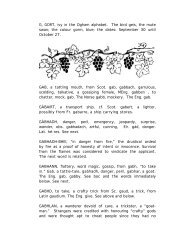L, luis, the mountain ash in the Ogham. Confers ... - Rodney Mackay
L, luis, the mountain ash in the Ogham. Confers ... - Rodney Mackay
L, luis, the mountain ash in the Ogham. Confers ... - Rodney Mackay
You also want an ePaper? Increase the reach of your titles
YUMPU automatically turns print PDFs into web optimized ePapers that Google loves.
The term corn is used universally to <strong>in</strong>dicate <strong>the</strong><br />
dom<strong>in</strong>ant gra<strong>in</strong> grown <strong>in</strong> a region and <strong>in</strong> most of Scotland<br />
that is now oats. In England "corn" meant wheat, while<br />
North Americans use <strong>the</strong> word to describe maize, and apply<br />
"gra<strong>in</strong>" to all o<strong>the</strong>r cereal crops.<br />
In speak<strong>in</strong>g of <strong>the</strong> New Year or Hogamanay, we have<br />
mentioned <strong>the</strong> customs relat<strong>in</strong>g to <strong>the</strong> creation of <strong>the</strong> Auld<br />
Hag, Cailleach Doll or Wrack, <strong>the</strong> name given <strong>the</strong> last sheaf<br />
if it were, unhappily, cut after Samha<strong>in</strong>n Eve. In parts of<br />
Scotland, <strong>the</strong> last sheaf was termed <strong>the</strong> "Maidhdean bua<strong>in</strong><br />
(<strong>the</strong> shorn virg<strong>in</strong>) if it could be taken before midnight,<br />
October 31st. While people made every effort to avoid<br />
hav<strong>in</strong>g to board <strong>the</strong> w<strong>in</strong>ter hag, <strong>the</strong>y vied for <strong>the</strong> honour of<br />
tak<strong>in</strong>g <strong>the</strong> Maiden, s<strong>in</strong>ce <strong>the</strong> s<strong>in</strong>gle person who obta<strong>in</strong>ed it<br />
was certa<strong>in</strong> to be married before <strong>the</strong> next harvest. To<br />
secure it, <strong>the</strong> reapers were often subtle, leav<strong>in</strong>g a sheath<br />
uncut and cover<strong>in</strong>g it with earth to fool <strong>the</strong> o<strong>the</strong>rs. This<br />
was a dangerous procedure s<strong>in</strong>ce <strong>the</strong> last cutt<strong>in</strong>g had to be<br />
complete before <strong>the</strong> open<strong>in</strong>g hours of November 1st. Once<br />
removed from <strong>the</strong> field, <strong>the</strong> Maiden of <strong>the</strong> Kern was made<br />
<strong>in</strong>to a be-ribboned doll and fixed to <strong>the</strong> farmhouse wall. In<br />
<strong>the</strong> north, she was preserved until Yule morn<strong>in</strong>g and <strong>the</strong>n<br />
divided among <strong>the</strong> cattle to make <strong>the</strong>m thrive. Elsewhere,<br />
<strong>the</strong> sheaf was reserved to be cut down by <strong>the</strong> youngest<br />
female reaper, and <strong>the</strong>n made <strong>in</strong>to a rude female doll clad <strong>in</strong><br />
a paper dress. This figure was kept over <strong>the</strong> w<strong>in</strong>ter <strong>in</strong> <strong>the</strong><br />
chimney corner until a new Maiden took her place <strong>in</strong> <strong>the</strong> next<br />
year. The harvest supper at <strong>the</strong> end of <strong>the</strong> cutt<strong>in</strong>g was<br />
itself called <strong>the</strong> Maiden <strong>in</strong> Balquidder.<br />
Details of <strong>the</strong> rite were extremely varied. In<br />
Dumbartonshire, <strong>the</strong> girl who cut <strong>the</strong> Maiden was thought to<br />
be lucky and certa<strong>in</strong> to be wed with<strong>in</strong> <strong>the</strong> year. Here, <strong>the</strong><br />
Maiden was hung <strong>in</strong> <strong>the</strong> kitchen, where she might be kept for<br />
several years with a date tag affixed. In some households<br />
numerous Maidens from various years were left hang<strong>in</strong>g<br />
from kitchen hooks. In <strong>the</strong>se regions, <strong>the</strong> supper which<br />
followed <strong>the</strong> cutt<strong>in</strong>g was called <strong>the</strong> Kern. At Garlock, <strong>the</strong><br />
last corn was graphically referred to as <strong>the</strong> Head or <strong>the</strong>



